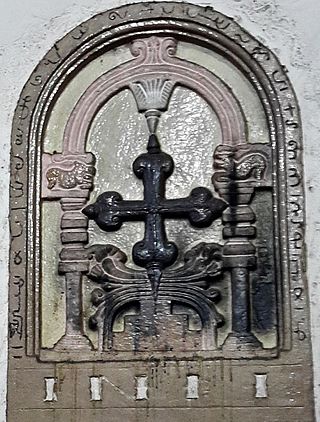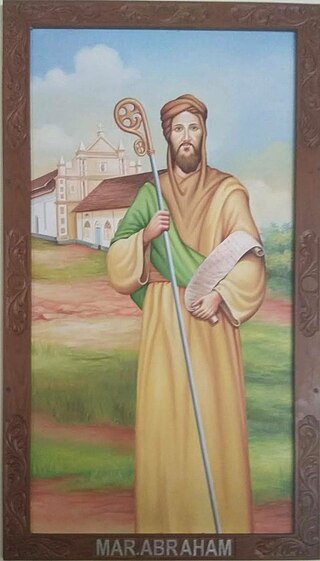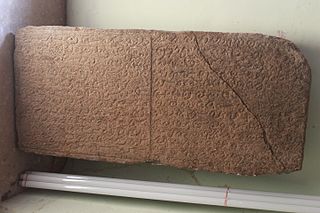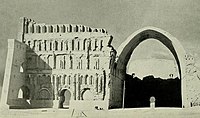This article includes a list of references, related reading, or external links, but its sources remain unclear because it lacks inline citations .(June 2022) |
Metropolitanate of All India ܒܬ ܗܙܕܐ | |
|---|---|
| Bishopric | |
 Metropolitan Abraham (1597) - the last Metropolitan of the Archdiocese | |
| Location | |
| Country | India |
| Territory | India and China |
| Ecclesiastical province | India |
| Metropolitan | From 8th century AD |
| Headquarters | several [1] |
| Information | |
| Denomination | Saint Thomas Christians |
| Sui iuris church | Church of the East |
| Rite | East Syriac Rite |
| Established | AD 50s [ citation needed ] |
| Cathedral | several [2] |
| Part of a series on |
| Eastern Christianity |
|---|
 |
Metropolitanate of India (Syriac: Beth Hindaye) was an East Syriac ecclesiastical province of the Church of the East, at least nominally, from the seventh to the sixteenth century. The Malabar region (Kerala) of India had long been home to a thriving Eastern Christian community, known as the Saint Thomas Christians. The community traces its origins to the evangelical activity of Thomas the Apostle in the 1st century. The Christian communities in India used the East Syriac Rite, the traditional liturgical rite of the Church of the East. They also adopted some aspects of Dyophysitism of Theodore of Mopsuestia, often inaccurately referred as Nestorianism, in accordance with theology of the Church of the East. [3] [4] [5] It is unclear when the relation between Saint Thomas Christian and the Church of the East was established. Initially, they belonged to the metropolitan province of Fars, but were detached from that province in the 7th century, and again in the 8th, and given their own metropolitan bishop. [6] [7]
Contents
- India-Persia Church relations from 3rd to 14th Century
- Sassanian period
- Umayyad period
- Abbasid period
- Seljuq period
- Mongol period
- Appointment of East Syriac bishops for India, 1490–1503
- Bishops from traditional and Chaldean Patriarchates and clashes with the Portuguese, 1503–99
- Rival bishops Abraham and Joseph Sulaqa reaching India
- Bishop Abraham joining in Chaldean Patriarchate
- Bishop Abraham as Metropolitan of Angamaly
- Synod of Diamper and latinisation
- 18th and 19th century Nestorian and Chaldean missions to India
- The mission of Shemʿon of Ada, 1701–20
- The mission of Gabriel of Ardishai, 1704–39
- The mission of Thoma Rokkos and Elias Mellus
- Chaldean Syrian Church of India
- See also
- References
- Sources
Due to the distance between India and the seat of the Patriarch of the Church of the East, communication with the church's heartland was often spotty, and the province was frequently without a bishop. An eleventh-century reference states that the metropolitan province of India had been 'suppressed', due to communication difficulties. [8] At the beginning of the fourteenth century the Indian Church was again dependent on the Church of the East. Although India was supplied with bishops from the Middle East, the effective control lay in the hands of an indigenous priest known as Arkkadiyakkon or Archdeacon. [9] He was the community leader of Saint Thomas Christians. Even in times when there were multiple foreign bishops, there was only one archdeacon for entire Saint Thomas Community. [10] As such, the Indian church was largely autonomous in operation, though the authority of the Patriarch was always respected.
In the 15th century, the Portuguese arrived in India. Initially, the relationship between native Saint Thomas Christians and the Portuguese were friendly. But gradually, the ritual diversities widened and the relationship deteriorated. After a section of the Church of the East became Catholic (modern day Chaldean Catholic Church) in 1553, both the Nestorian and Chaldean Churches intermittently attempted to regain their old influence in India by sending their bishops to the Malabar Christians. In 1565, the Chaldean Catholic Archdiocese of Angamaly was established to provide jurisdiction for the Chaldean Church in India. On occasion the Vatican supported the claims of Catholic bishops from the Chaldean Church. However, the Portuguese ascendancy was formalised at the Synod of Diamper in 1599, which effectively suppressed the historic East Syriac metropolitan province of India. Angamaly, the former seat of the East Syriac metropolitan diocese, was downgraded to a suffragan diocese of the Padroado Archdiocese of Goa.
Today, the Chaldean Syrian Church of India is the continuation of the East Syriac ecclesiastical province in the Indian subcontinent, being an archdiocese of the Assyrian Church of the East. [11] It has around 15,000 communicants. [12]










